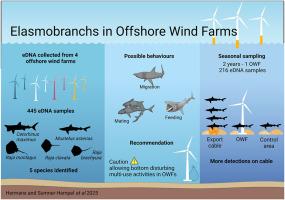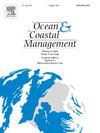在海上风力发电场中
IF 5.4
2区 环境科学与生态学
Q1 OCEANOGRAPHY
引用次数: 0
摘要
沿海海域海上风电场(owf)的发展为受威胁的板蝗种群带来了风险和机遇,但其对板蝗种群存在和栖息地利用的实际影响尚不清楚。随着越来越多的自由渔场被规划,由于渔业、保护和能源部门的需求日益重叠,可用空间的缺乏给利益相关者带来了创造多用途区域的压力。需要深入了解这些需求之间的相互作用,以支持决策者进行海洋空间规划和管理决策。其中一个重要的问题是,野生动物在多大程度上影响板蝗的存在和栖息地的利用。在这里,我们(i)确定在owf中elasmobranch的发生,(ii)确定elasmobranch的存在是否在采样地点之间变化,以及(iii)调查季节性对elasmobranch存在的影响。我们在4个渔场内采集了436份海水样本,确认存在5种不同的板鳃目物种(2种鲨鱼,3种鳐)。在4个owf中,elasmobranches的总检出率为8.5%。为期两年的季度取样活动证明了海底电缆上的Mustelus asterias的季节性,这与该物种已知的迁徙运动相对应。我们的研究结果证实,鲨鱼和溜冰鞋存在于owf中。我们建议在引入可能抵消底拖网渔业排除的好处的多用途活动时要谨慎。调查这些受威胁物种如何利用野生生物保护区,将有助于决策者根据欧盟立法法案,包括《栖息地指令》、《MSFD》、《2030年生物多样性战略》和《自然恢复法》,确定野生生物保护区的(多用途)功能。本文章由计算机程序翻译,如有差异,请以英文原文为准。

Elasmobranchs in offshore wind farms
The development of offshore wind farms (OWFs) in coastal seas presents both risks and opportunities for threatened elasmobranch populations, but their actual influence on elasmobranch presence and habitat use remains unclear. As more OWFs are planned, the lack of available space puts pressure on stakeholders to create multi-use areas as demands from fisheries, conservation and the energy sector become increasingly overlapping. Insight into interactions between these demands is needed to support policymakers in marine spatial planning and management decisions. One of the important questions is to what extent OWFs influence elasmobranch presence and habitat use. Here, we (i) ascertain elasmobranch occurrence in OWFs, (ii) determine whether elasmobranch presence varies between sampling locations, and (iii) investigate the influence of seasonality on elasmobranch presence. We collected 436 seawater samples within four OWFs and the presence of 5 different elasmobranch species (2 sharks, 3 skates) was confirmed. The overall detection probability of elasmobranchs in the four OWFs was 8.5 %. A quarterly sampling campaign over 2 years demonstrated the seasonality of Mustelus asterias on the subsea power cables, which corresponded with known migratory movements of this species. Our findings confirm that sharks and skates are present in OWFs. We advise caution when introducing multi-use activities that could counteract the benefits of bottom trawling fisheries exclusion. Investigating how these threatened species use OWFs would aid policymakers in determining the (multi-use) function of OWFs in terms of EU legislative acts including the Habitat Directive, MSFD, Biodiversity Strategy 2030 and the Nature Restoration Law.
求助全文
通过发布文献求助,成功后即可免费获取论文全文。
去求助
来源期刊

Ocean & Coastal Management
环境科学-海洋学
CiteScore
8.50
自引率
15.20%
发文量
321
审稿时长
60 days
期刊介绍:
Ocean & Coastal Management is the leading international journal dedicated to the study of all aspects of ocean and coastal management from the global to local levels.
We publish rigorously peer-reviewed manuscripts from all disciplines, and inter-/trans-disciplinary and co-designed research, but all submissions must make clear the relevance to management and/or governance issues relevant to the sustainable development and conservation of oceans and coasts.
Comparative studies (from sub-national to trans-national cases, and other management / policy arenas) are encouraged, as are studies that critically assess current management practices and governance approaches. Submissions involving robust analysis, development of theory, and improvement of management practice are especially welcome.
 求助内容:
求助内容: 应助结果提醒方式:
应助结果提醒方式:


